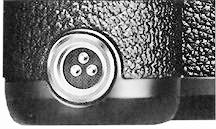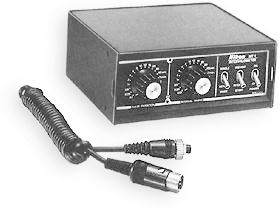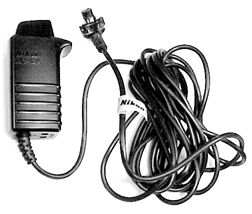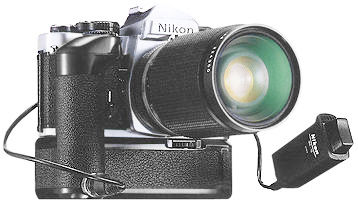Another reason to have a MD-12 on your camera is its ability to go remote photography. The physical body of the FM, FE series and the FA camera itself does not has any built-in remote capability incorporated (Other than cable release operation), unlike some of the newer autofocus bodies that has a built in remote sensor and permits limited range remote operations.
 |
In short, you have to have the MD-12 for remote and unmanned photography. It is by a medium of a motor drive in either MD-11, MD-12 or MD-15. The front portion, at the bottom of the hand grip is the remote terminal socket for mounting such accessories. |
In the Nikon photographic
system, remote photography covers time lapse photography as well. Time lapse means
taking of a series of photographs over a period of time from a fixed position for
astronomy, scientific, general or even macro applications, this can be accomplished
with your MD-12 equipped camera and a suitable timing device. Timing devices for
time lapse photography starts from the Nikon Intervalometer MT-1/MT2, for example,
usually have two variable controls: one for pulse duration and the other for interval
time. Pulse duration refers to the length of time that the triggering pulse lasts.
Interval time is the time interval between pulses and governs the frequency of the
photographs. Additionally, the S-C selector on the MD-12 provides you with the option
of taking single photographs or shooting in bursts. This is the
older version of the Intervalometer MT-1. The upgrade, MT-2 is quartz control for
a even more precise timing.
 |
Click here to view. Beauty is, the MD-12 works with the new and older versions of most of these accessories. Thus, depends on your requirement and how frequent you are using these, the used market may provide a bargaining source for you to try them out. With the S-C selector set to "S," one exposure will be made for each triggering pulse, the motor winding on automatically at the end of the triggering pulse or the exposure, whichever is longer. The interval time can be set at any duration, but avoid setting the trigger pulse longer than the interval time. Otherwise continuous or erratic operation will occur. |
 |
With the S-C selector set to "C," if the triggering pulse's duration is longer than the shutter speed set (or 0.25 sec. in the case of the higher shutter speeds), bursts will be fired at each interval. For example, if the shutter speed is set at 1/1000 sec., and the trigger pulse duration is 2 sec., then approximately 7 exposures will be made at each interval. Generally speaking you will find that operation with the S-C selector set to "S" and the trigger pulse duration set between 0.1 and 0.25 sec. is advisable for the majority of time lapse situations. |
 |
The variable trigger pulse duration found on some intervalometers is a feature necessitated by the design of the older generation of motor drives such as the MD-11, and is largely redundant with the MD-12. Time lapse photography is not possible with the shutter speed dial set to "B." Should you attempt this, the camera's mirror may lock up, with the shutter remaining open, making operation impossible. To restore normal operation in the event of this happening, merely turn the shutter speed dial away from the "B" setting. |
In some of the latest autofocus cameras, some of these basic functions such as interval timer, is by means of some specialized camera film backs (e.g. Command Backs in F90X, F4 (MF-26) and F5 (MF-28) provides more functions than just interval timer). It may not be that precise as the MT-1/MT2 in close monitoring or flexibility's for fine adjustments.
Previous | Next Page | Part IV of VII - Remote photography ? More options...
| Back | to Index Page of
MD-12 | * MD-11 | Back | to Main Index Page Shared Resources
Instruction
Manual
: PDF (224k)
| 3rd
Party Power Winder Only for FM2(n)/FE2/FA
Specification: PDF(121k) | HTML
| Operation manual (PDF Format:
202k)
| Back | to Main Index Page Shared
Resources (Screens, Databacks and general accessories)
| Message Board | for
your favourite Nikon
FE series models
| Message Board | for
your favourite Nikon
FM series models
| Message Board | for
your favourite Nikon
FA series models
| Message Board | for your Nikon Optics
in a shared environment
| Message Board | Specifically for Dispose or Looking for Nikon / Nikkor
Photographic Equipment
Shared
Resources: MD-11 | MD-12 | 3rd Party Power Winder Only for FM2(n)/FE2/FA
| Focusing Screens | Titanium Shutter | Flash Units -
| SB-15 | SB-10 | SB-16B & Other Options | Databack | Nikkor lens mount (related
info)
Others:- Nikon AF-TTL Speedlights | SB-20 (1986) | SB-22 (1987) | SB-23 | SB-24 (1988) | SB-25 (1991/2) | SB-26 (1994) | SB-27(1997) | SB-28 (1997) | Nikon SB-29(s) (2000) | Nikon SB-30 (2003) | Nikon SB-600 (2004) | Nikon SB-800 (2003) Nikon AF-TTL Speedlight DX-Series: Nikon SB-28DX (1999) | SB-50DX (2001) | SB-80DX (2002)
Nikon
BC-flash Series |
Original
Nikon Speedlight
SB-2
| SB-3
| SB-4
| SB-5
| SB-6
| SB-7E
| SB-8E
| SB-9
| SB-E
| SB-10
SB-11
| SB-12 | SB-14 | SB-140 UV-IR| SB-15 | SB16A | SB-17 | SB-18, SB-19 | SB-21A (SB-29) Macro flash | Flash Accesories | SF-1
Pilot Lamp
| Nikon F | Nikon F2 | Nikon F3 | Nikon F4 | Nikon F5 | Nikon F6 | Nikkormat / Nikomat | Nikon FM | Nikon FE/ FA | Nikon EM/FG/FG20 | Nikon Digital SLRs | Nikon - Other models |
Nikon Auto Focus Nikkor lenses:- Main
Index Page
Nikon Manual Focus Nikkor lenses:- Fisheye-Nikkor Lenses - Circular | Full Frame |
Ultrawides Lenses - 13mm15mm18mm20mm | Wideangle Lenses - 24mm28mm35mm | Standard Lenses - 45mm 50mm 58mm | Telephoto
Lenses - 85mm105mm135mm180mm & 200mm | Super-Telephoto Lenses - 300mm 400mm 500mm 600mm 800mm 1200mm |
 Index Page |
Special
Application lenses: Micro-Nikkor Lenses - 50mm~55mm -60mm 85mm -105mm 200mm Micro-Zoom 70-180mm Perspective Control (PC) - 28mm 35mm PC-Micro 85mm Dedicated Lenses for Nikon F3AF: AF 80mm f/2.8 | AF 200mm f/3.5 EDIF Depth of Field Control (DC): 105mm 135mm Medical Nikkor: 120mm 200mm Reflex-Nikkor Lenses - 500mm 1000mm 2000mm Others: Noct Nikkor | OP-Nikkor | UV Nikkor 55mm 105mm | Focusing Units | Bellows-Nikkor 105mm 135mm Nikon Series E Lenses: 28mm35mm50mm100mm135mm | E-Series Zoom lenses: 36~72mm75~150mm70~210mm |
MF Zoom-Nikkor Lenses: 25~50mm | 28~45mm | 28~50mm | 28~85mm | 35~70mm | 36~72mm E | 35~85mm | 35~105mm | 35~135mm | 35~200mm | 43~86mm | 50~135mm | 50~300mm | 70~210mm E | 75~150mm E | 80~200mm | 85~250mm | 100~300mm | 180~600mm | 200~400mm | 200~600mm | 360~1200mm | 1200~1700mm
Tele-Converters: TC-1 | TC-2 | TC-200 | TC-201 | TC-300 | TC-301 | TC-14 | TC-14A | TC-14B | TC-14C | TC-14E | TC-16 | TC-16A | TC-20E
Recommended links to understand more technical details
related to the Nikkor F-mount and production Serial Number:
http://rick_oleson.tripod.com/index-153.html by: my
friend, Rick Oleson
http://www.zi.ku.dk/personal/lhhansen/photo/fmount.htm by: Hansen,
Lars Holst
http://www.mir.com.my/rb/photography/hardwares/nikonfmount/lens2.htm
http://www.photosynthesis.co.nz/nikon/serialno.html
W A R N I N G: The New G-SERIES Nikkor lenses have no aperture ring on the lens, they CANNOT ADJUST APERTURES with any of these manual focus Nikon FE series SLR camera models; please ignore some portion of the content contained herein this site where it relates.
|
Back | Main Index Page of Nikkor Resources
|
Back | Main Index Page of Pictorial
History of Nikon SLRs
| Message Board | for your Nikkor optics ("shared" because I do wish some of you to expose to other's perspective as well. Isn't it a sad sate to see photography has to be segmented into different camps from the use of various labels)
about this photographic web site
Home - Photography in Malaysia |
A contributing effort to Michael C Liu's Classic Nikon Site.
Credit: Chuck Hester for some of his beautiful images used in this site; Ted Wengelaar®, Holland for his continuous flow of input; Lars Holst Hansen, Danish 'Hawkeye' who shares the same passion; Mr Poon from Poon photo for their input; Ms Miss Rissa (Sales Manager) & members of the Technical Service dept. of Shriro Malaysia, local distributor of Nikon cameras in Malaysia & Singapore, in providing so many useful input to make this site possible. Special thanks to Mr MC Lau, who has helped with his images of the MF-12 databack. Michael Tan, Pertama Photo (603-2926505) for lending his original Titanium Shutter Display Unit. Dave Hoyt who has prepared the introductory page and offer some images of his FE2 in this site.. Hiura Shinsaku, Nikomat ML, Japan for his contribution on all the various images; A contributing site to a long lost friend on the Net. Note: Certain content and images appeared in this site were either scanned from official marketing leaflets, brochures published by Nikon and/or contribution from surfers who claimed originality of their own work to publish in this site based on educational merits. The creator of this site will not be responsible for any discrepancies that may arise from such possible dispute except rectifying them after verification."Nikon", "Nikkormat", "Nippon Kokagu KK" & "Nikkor" are registered tradename of Nikon Corporation Inc., Japan. Made witha PowerMac.